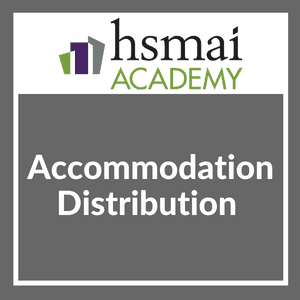
By Jackie Douglas on 29th March, 2019
Distribution strategy is one of the important areas of revenue management for most hoteliers.
Which channels should you be on? Which ones are giving you bookings? What about cancellation rates? And are some bookings or channels more valuable than others?
There’s only one way to answer those questions: data. It can be hard to tell which data is useful to give you the insights you need to make these decisions so we have developed a quick guide to which data you should be looking at to improve your hotel distribution strategy. Once you’ve looked at this data for your property, you will be much more informed and therefore, the decisions will be easier, and be evidenced by facts. Checkout our top 10 data facts to drive distribution!
1. Growing or Declining share
Be sure to put the results you’re getting from each channel in context. Don’t just look at month and year to date (YTD) results, make sure you graph this and compare to the same period last year.
Make sure you compare to what was happening in your hotel at the same time last year. Did you decline on the OTA but you were actually fully booked with a group so there was no space? Did you grow your share because you ran a special offer because you were empty? Weather? Natural event? New/media? Context. Keep a record of what was happening in the market at the time so that next year you know that the increase in demand was due to a specific event.
2. Demand data
Look at search and booking patterns per channel. In other words, who is looking and who is booking on each channel. Crucially, when are they searching and booking?
Some will have shorter or longer search and booking windows, which will let you see when they perform well, and where they fit in overall performance. OTA dashboards can help by providing some of this data. You can also purchase data from various vendors, for example, TravelClick, OTA Insight, and some Revenue Management Systems.
Booking source. Guests from some countries will pay more, or book on a longer lead time so check where your guests are coming from and is that a market you want to grow. Does that source market deliver a high ADR? Compare to your market and your comp set as there might be a country you should be targeting.
3. Cost of distribution
i.e. Revenue less Commission and Fees
Calculate your net revenue per channel and compare the Cost of Distribution for each channel. This lets you see the true value of a channel and how much it’s costing you. Try compiling all this information into an Excel document or something similar to easily compare it. Don’t forget that your direct channel also has fees and charges, this might be a booking fee or commission to your booking engine provider or the cost of taking a phone reservation.
4. Stayed Bookings (Actual)
Look at how many actual stays each channel gives you. The difference between arrival bookings per month and stayed arrival bookings (which takes out cancellations) demonstrates who’s booking versus staying. As many OTA’s are offering free cancellation to their customers, make sure you’re reviewing your data after the stay date to see the real number of room night or guests that actually stayed as opposed to those that booked and cancelled before arrival. Which channels have the highest % of non-arrivals (Cancellations) and what can you do to decrease this, is this channel worth working with?
5. Stayed Bookings (Cancellations)
Along with Actual stayed data, take a look a bit deeper at cancellations. Check out:
- The percentage of monthly cancellations
- The booking lead time for these cancellations
- Are some channels holding rooms a long way out from arrival but cancelling closer to arrival date? If this is happening, you might want to pull back on the inventory you’re offering those channels or change the lead time of when you give them access to inventory.
Look to anecdotal evidence. Are you in a tourist destination where people cancel once the weather report turns bad? Do you need to extend your cancellation policy to protect against these late cancellations. Do you have, or do you need to add a deposit policy?

6. Day of the Week
Review which days of the week channels are providing booking on. Are some channels just cramming high demand dates, without encouraging bookings on gap dates? Or just weekdays as opposed to weekends? You may not be able to change this mix, but knowing this data means you can more easily determine which channel can give you more weeknight bookings, for example.
Consider adding a minimum stay to protect yourself midweek. Or a “stay longer and save” offer to increase the shoulder nights.
7. Average Daily Rate (ADR)
Examine your Average Daily Rate per rate plan, and also take a look at the overall ADR for the channel.
Not all channels are created equal. Looking at your ADR per channel will show you whether some channels are heavy on discount rates, and if others are generating higher value bookings.
8. Average Length of Stay (ALoS)
Review the Average Length of Stay per channel. Is there a pattern to longer or shorter stays depending on the channel used?
If there is a pattern, this could be a few reasons for this:
- The rate plans you have offered and are available in that channel
- How they’re being promoted.
- The type of customers that channel attracts
Don’t be afraid to look a little deeper to find out what’s behind stay lengths.
9. Location/ Source of distribution
Review bookings by geographic location to see which channels are strong for which geographic markets.
This can help you see the potential to work where market activity is focused to drive direct bookings. OTAs can give you visibility in markets you might not be able to reach on a property level. For example, you might find Expedia is providing a high volume of customers from North America. So, if you’re not doing any marketing in North America, you might consider increasing inventory to the channel is spending money attracting customers in markets you’re not focused on.
You can also look at Expedia reports to see if a particular channel they own is producing eg Wotif or if they are delivering package rates v promo rates v BAR. Which channels are best for your property?
10. Hotel Inventory
Make sure you have ample inventory and rates loaded for each channel. Don’t unintentionally limit a channel! Make sure you’re continually updating the inventory and rates for the next 12 months. If you do this on a monthly rolling basis, you’ll be maximising the potential for consumers to see your hotel on various channels.
Take action!
We hope this short guide has given you a good starting point for finding out how your hotel distribution strategy is going. Conduct a regular review of your channels and how they’re performing.
You can also learn more in our unique online courses for hoteliers. Try the “Getting started with Business Intelligence” or the “Accommodation Distribution” course from only US$50.
-
 Introduction to Business Intelligence$55.00 – $65.00
Introduction to Business Intelligence$55.00 – $65.00 -
 Accommodation Distribution$55.00 – $65.00
Accommodation Distribution$55.00 – $65.00

